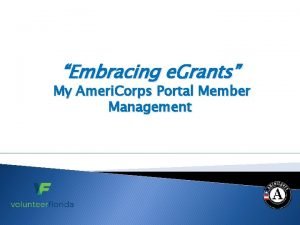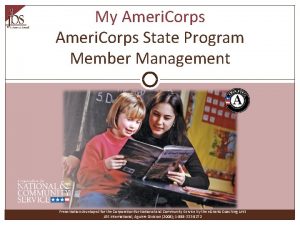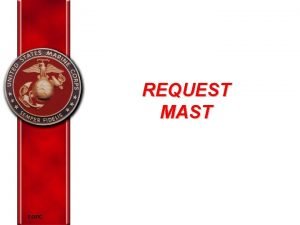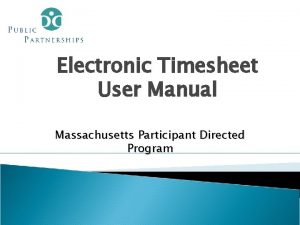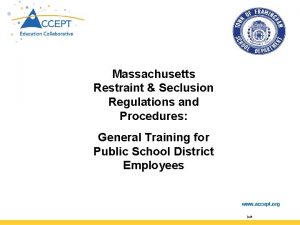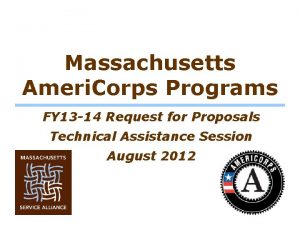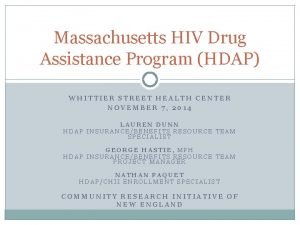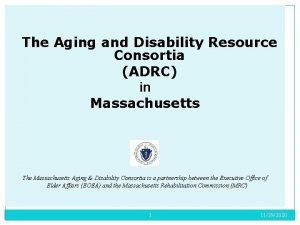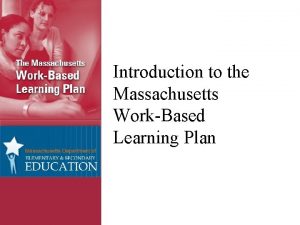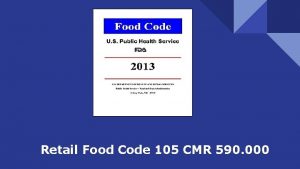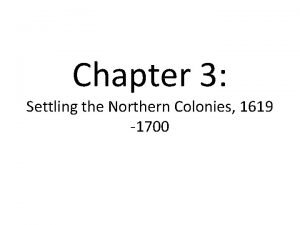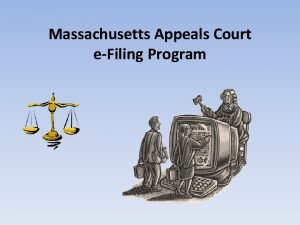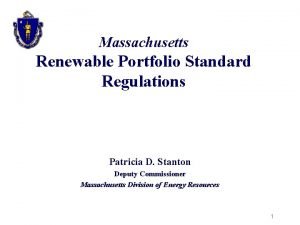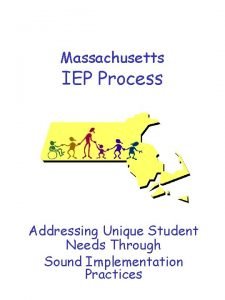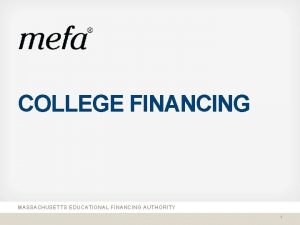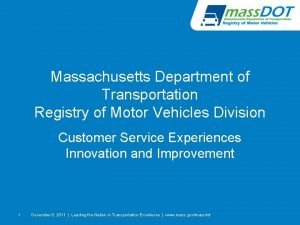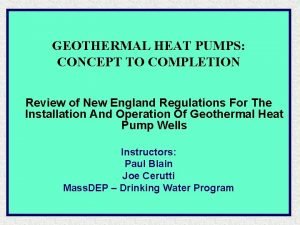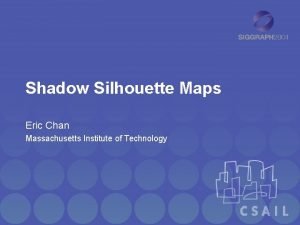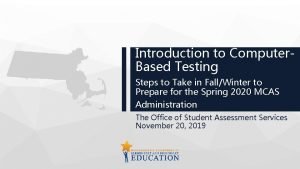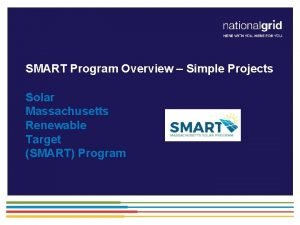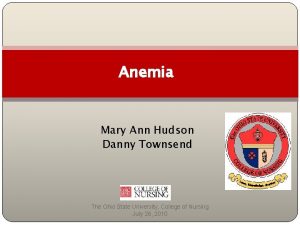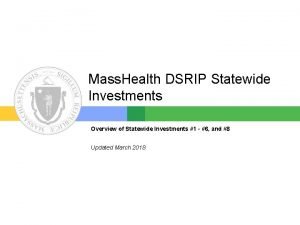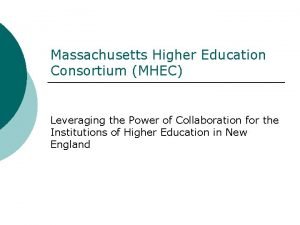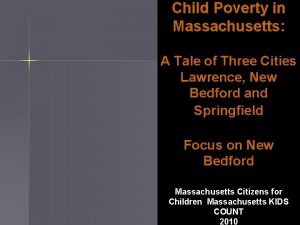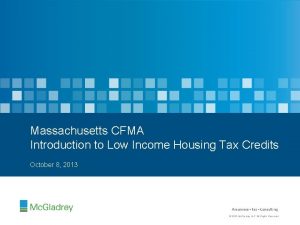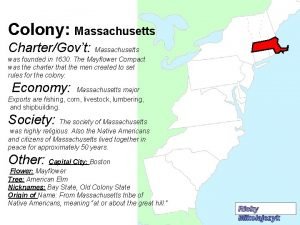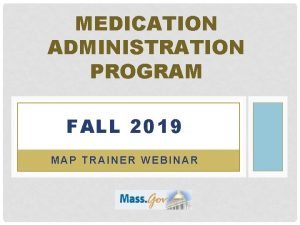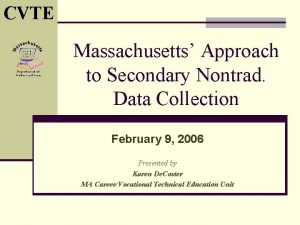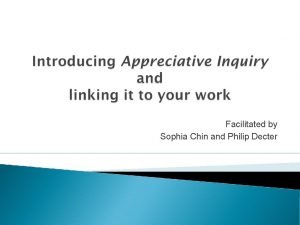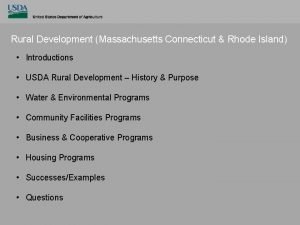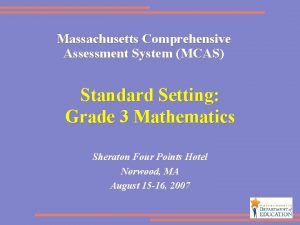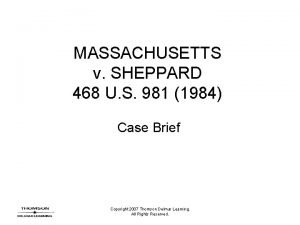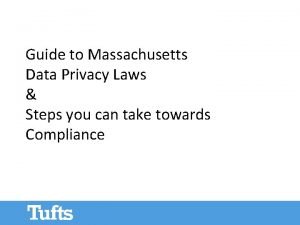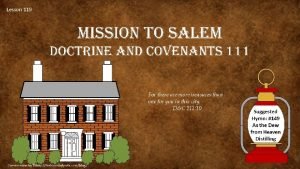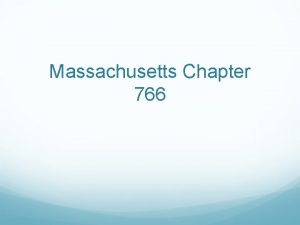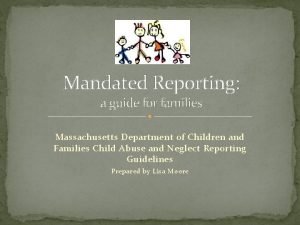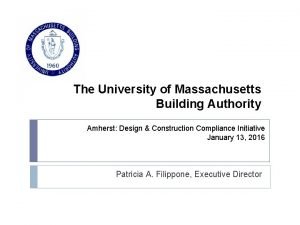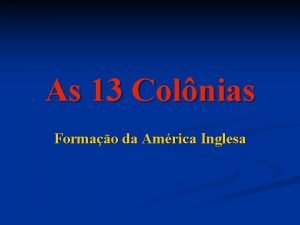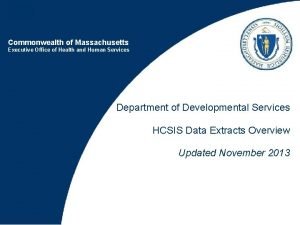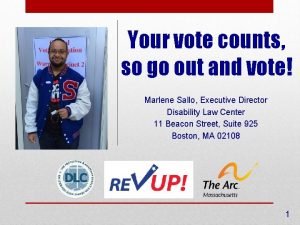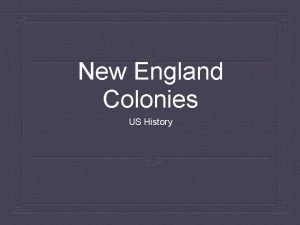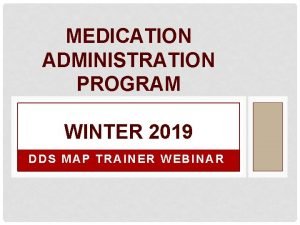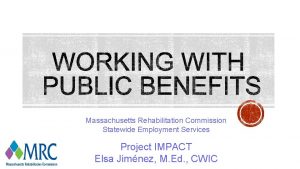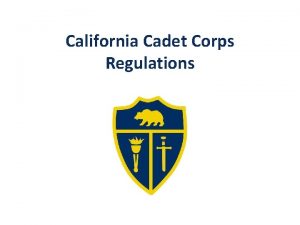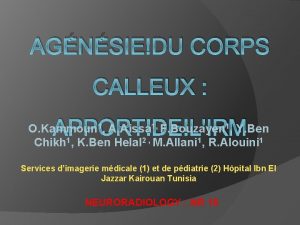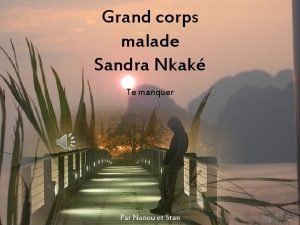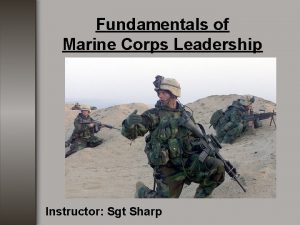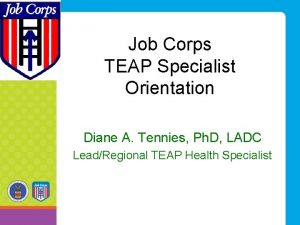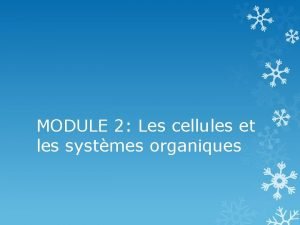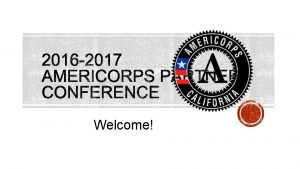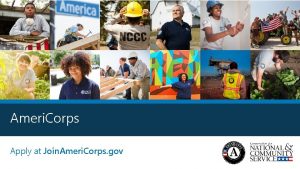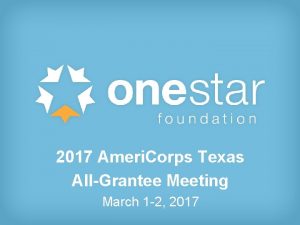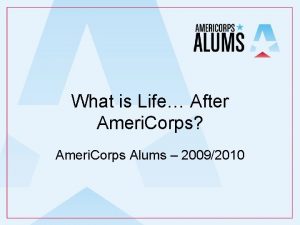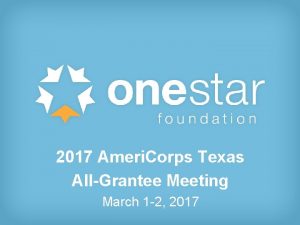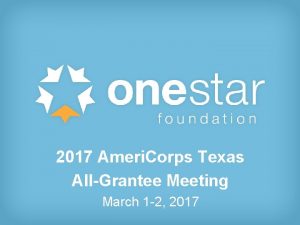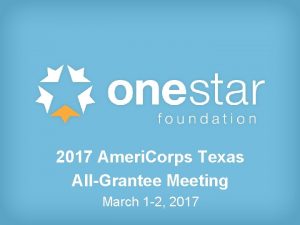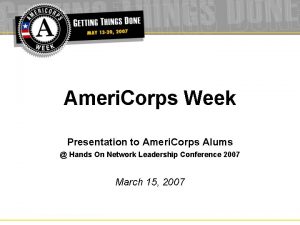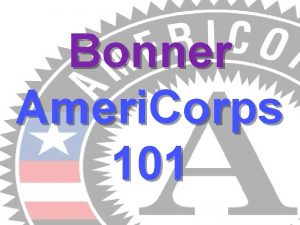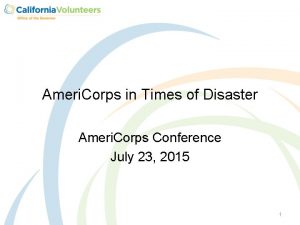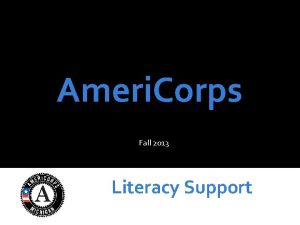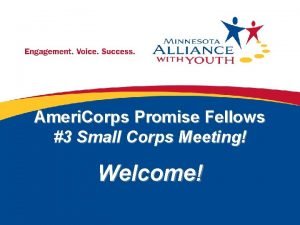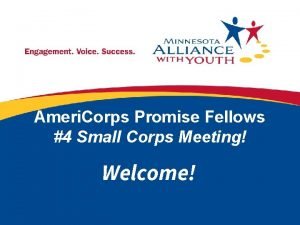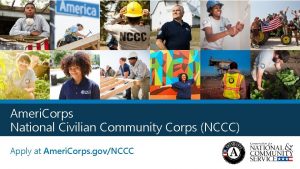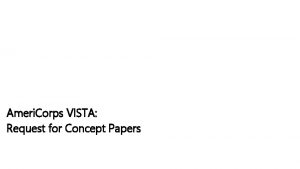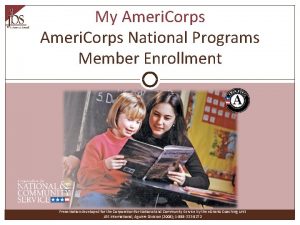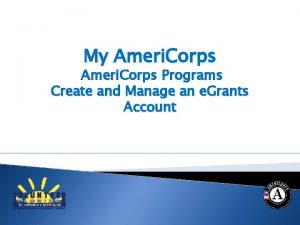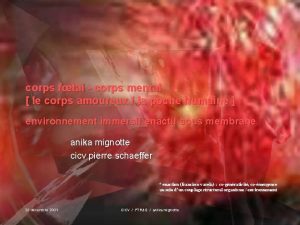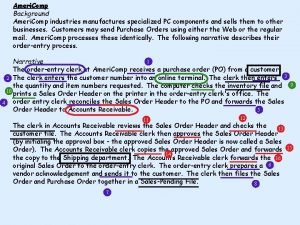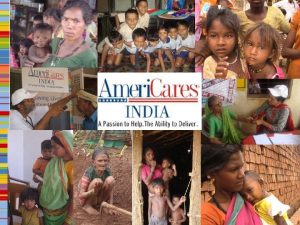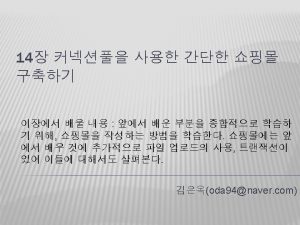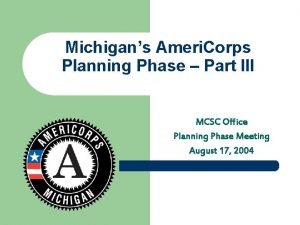Massachusetts Ameri Corps Programs FY 13 14 Request



























































- Slides: 59

Massachusetts Ameri. Corps Programs FY 13 -14 Request for Proposals Technical Assistance Session August 2012

Massachusetts Service Alliance The Massachusetts Service Alliance, established in 1991, is a private, nonprofit organization that serves as the governor appointed state commission on community service and volunteerism.

Our Mission Our mission is to catalyze the innovation and growth of service and volunteerism by creating partnerships that maximize resources, expertise, capacity, and impact.

Massachusetts Service Alliance How we achieve our mission: – Invest public and private funds in community-based organizations. – Convene and mobilize public and private entities to link strategies related to service and volunteerism. – Build capacity of nonprofit agencies through training and technical assistance. – Advocate for the development and promotion of public policies and private initiatives that incorporate service as an effective strategy.

CNCS The mission of the Corporation for National and Community Service is to improve lives, strengthen communities, and foster civic engagement through service and volunteering.

CNCS Strategic Plan 2011 -15 Goal #1 Increase the impact of national service on community needs in communities served by CNCS-supported programs. Goal #2 Strengthen national service so that participants engaged in CNCS-supported programs consistently find satisfaction, meaning and opportunity.

State and National

What is Ameri. Corps? Ameri. Corps is a network of local, state, and national service programs that connects more than 85, 000 Americans (approximately 2, 000 in MA) each year in intensive service to meet our country’s critical needs including: – – – – Tutoring and mentoring disadvantaged youth Fighting illiteracy Improving health services Building affordable housing Cleaning parks and streams Managing or operating after-school programs Helping communities respond to disasters Building organizational capacity

Ameri. Corps is… • A year of stipended service • A team of members addressing compelling needs • A way to leverage local and federal resources • Not just a grant or funding source but a PROGRAM • A way to build organizational capacity to meet needs through volunteer generation and partnership building

CNCS FOCUS AREAS: Per the Kennedy Serve America Act: • Education • Healthy Futures • Environmental Stewardship • Veterans and Military Families • Economic Opportunity • Disaster Services

MSA Focus Areas • Geographic and programmatic diversity • Effective solutions that meet community needs • Meaningful member service experiences • Volunteer generation • Demonstrable impact • Early Childhood Literacy

Types of Grants OPERATING GRANTS EDUCATION AWARD PROGRAMS (EAP) Organization receives federal funds for program/member support costs Organization supports most program/ member costs through non-CNCS funds Maximum CNCS request per MSY is $13, 300 Maximum CNCS request per MSY is $800 Members receive living allowance Members do not receive living allowance Members eligible for education award Financial match requirement No match requirement ALL grantees must follow the Ameri. Corps Regulations, Provisions, and MSA Addendum to the Provisions

Types of Awards • Competitive – Funds awarded by CNCS – MSA submits Full Applications to CNCS – Submissions compete nationally against all single- and multi-state applicants • Formula – Federal funds given to MSA based on Ameri. Corps federal allocation and state population – No separate application process

Applying for Ameri. Corps

Eligible Applicants • Public or private non-profit organizations including: – – – labor organizations community organizations faith-based organizations institutes of higher education state agencies government entities within the state (e. g. , cities, counties) – Indian Tribes • Partnerships or consortiums of the above

Ameri. Corps Member Eligibility An Ameri. Corps Member must: - be a U. S. citizen, U. S. national or lawful permanent resident of the United States - be at least 17 years of age (unless in a specifically designated youth corps) - have a high school diploma or equivalent, or agree to obtain a high school diploma or its equivalent before using an education award

Prohibited Activities Ameri. Corps members and the volunteers they recruit/coordinate may not engage in specific prohibited activities All prohibited activities outlined in the Ameri. Corps Regulations/ Provisions and Application Instructions: http: //www. americorps. gov/for_organizations/manage/index. asp Individuals may exercise their rights as private citizens and may participate in the above activities on their initiative, on non. Ameri. Corps time, and using non-Corporation funds. The Ameri. Corps logo should not be worn while doing so.

Prohibited Activities • Attempting to influence legislation • Protests, petitions, boycotts, or strikes • Promoting or deterring union organizing • Impairing existing contracts for services or collective bargaining agreements • Engaging in political activities to influence outcome of an election or to advocate for or against political parties, candidates, or elected officials • Conducting religious instruction or worship services • Providing a direct benefit to a for-profit • Voter registration drives • Providing or making referrals for abortion services

Timeline Concept Papers are due to MSA by Wednesday, September 19, 2012 by 12: 00 pm • August 20, 2012 Ameri. Corps Concept Paper RFP Released • August 29 & 30 and Technical Assistance Sessions September 5, 2012 • September 6, 2012 Intent to Apply Form Due (optional online form) • September 19, 2012 Concept Papers due to MSA by noon • Late September/Early October Community review of all Concept Papers • Late October 2012 Notification of status • November 20, 2012 Draft of Full Applications due to MSA by noon • December 21, 2012 Full Application entered into e. Grants • Early January 2013 MSA submits applications to CNCS • May/June 2013 Notification of Competitive Award • Late June 2013 Notification of Formula Award

The Concept Paper I. Facesheet II. Program Model, Design, Location and Focus (worksheet) III. Executive Summary (1 page, double spaced, 12 pt Times New Roman font) IV. Narrative (10 pages, double spaced, 12 pt Times New Roman font) V. Service Categories (worksheet) VI. Performance Measure and Logic Model (worksheet) VII. Budget VIII. Authorization, Assurances and Certifications IX. Additional Required Information a. b. c. Organizational Chart Audit Proof of eligibility

The Concept Paper – Executive Summary Program snapshot • Mission statement • Purpose • Need • Planned Service Activities • Outcomes and Measurement 1 page, double-spaced, 12 pt Times New Roman

The Concept Paper - Narrative A. 1. 2. 3. 4. B. Program Design Problem and Solution Member Support Community Engagement Program Impact Organizational Capability 1. Programmatic and Fiscal Oversight 2. Staffing 3. Special Circumstances 10 pages, double-spaced, 12 pt Times New Roman

Program Design Problem and Solution Focus Areas – What is the community need? – Why Ameri. Corps to solve the identified problem? Member Activities – What will your members do to address the need? – How often will they serve? – Daily/Weekly member schedule – What evidence supports that the proposed intervention will work? Program Size/Structure – How many members are needed to successfully carry out activities? – Where will members serve?

Program Design Volunteer Generation Community volunteers can help Partnership/ Collaboration Solution Ameri. Corps members’ service Community Engagement PROBLEM Outcome Showing Impact Prepared for success Recruitment, selection, training & support

Program Size/Structure Ameri. Corps members may: -Serve in teams, pairs, or individually -Serve in a single neighborhood, city-wide, regionally, or state-wide -Serve through one organization or be placed with service partner organizations Describe how many members will serve at each site

Program Size/Structure Your program should be large enough to make a significant impact in your community. Minimum size: 10 Member Service Years (equivalent of 10 FT) Recommended minimum: 15 -20 Member Service Years

Member Service • At least 80% of member service hours must be direct service • Up to 20% of member service hours may be in education, training, or other member development activities • 10% of member service hours (considered direct service) may be in fundraising activities directly related to the member’s service (not for program operational funds)

Member Service Years Programs must request at least 10 Member Service Years Term of Service Minimum # of Hours MSY Full Time 1700 1. 000 One Year Half Time 900 0. 500 Reduced Half Time 675 0. 381 Quarter Time 450 0. 2646 Minimum Time 300 0. 2117

Program Size/Structure EXAMPLE: 20 full-time members = 20 MSY 40 half-time members = 20 MSY 76 quarter-time members = 20. 14 MSY 10 full-time, 5 part-time, and 29 quarter-time = 20. 185 MSY Provide rationale for number and type(s) of members requested If different type(s) of members, clearly explain the roles and activities associated with each

Program Design Member Support • Recruitment and Selection • Member Development and Training • Member Supervision

Recruitment & Selection Member Recruitment Processes for: – Recruiting members for your Corps • Who is your ideal member? Why? • Where will you seek them? – Diverse members • Members reflecting and/or from the community served • People with disabilities • Diverse age, background, experience, etc.

Recruitment & Selection Member Selection – Selection process: application, reference checks, interview(s), etc. – Criteria to evaluate applicants based on the essential functions of the position – Ensure a uniform selection process for each applicant

Member Development & Training Describe the plan to prepare members for service, provide ongoing personal/professional development, and promote a lifelong ethic of service Orientation: – Timeline – Ameri. Corps/National Service, MSA, the community, and their placement site(s) – Terms of Service – Prohibited Activities – Training/preparation for service activities – Teambuilding/corps identity – Additional topics for your organization and program

Member Development & Training Ongoing Development/Training: – Opportunities throughout the service year - timeframe – Proposed topics: training to support service activities and member personal/professional development – Fostering esprit de corps and a connection to the national service movement – Promoting an ethic of service and a lifelong commitment to civic responsibility – Planning/preparing for Life After Ameri. Corps Members’ participation in Ameri. Corps should be a meaningful and defining experience

Member Supervision • Year-long supervision plan including frequency and structure (e. g. , 1 -on-1 or group supervision) • Identify staff person(s) who will supervise members – If multi-site, explain how site partners are prepared to supervise members • Plan for recognizing members’ achievements AMERICORPS MEMBERS CANNOT SUPERVISE OTHER AMERICORPS MEMBERS

Community Engagement • Volunteer Generation – Utilize non-Ameri. Corps community volunteers to expand the reach of the program – Role(s) of volunteers – Members’ roles in recruiting and supporting community volunteers – State the number of volunteers your program will leverage • Partnerships and Collaborations – Identify stakeholders in the Ameri. Corps program, including existing or planned partnerships/collaborations – Identify stakeholders’ role in implementing/evaluating program

Program Impact What about the identified problem will change as a result of Ameri. Corps members’ service? • Anticipated change by the end of the three-year grant cycle • Measure and report on impact annually • Measurable annual outputs and outcomes as a result of primary service activities

Organizational Capability Applicants should have the organizational structure to: – – – – Manage a federal grant Provide sound programmatic and fiscal oversight Support appropriate program and fiscal staff positions Operate on a reimbursement basis Raise required matching funds Select and oversee site partners (if applicable) For Multi-site programs: *Capacity to support and oversee service sites *Process for selecting sites

Organizational Capability Staffing • Programmatic and fiscal for the program (full-time Program Director) • Relevant background or qualifications for open position(s) • Recruit, select, train, support new and current staff

Performance Measures Submit one Logic Model and one corresponding Performance Measure Worksheet related to members’ Primary Service Activities. – Reflect activities of all members – Capture the impact of the entire program Programs may have more than one PM if additional need(s) served through program (e. g. , member development). – Logic model and PM worksheet required for each measure

Performance Measures describe the measurable outputs and outcomes the program expects to achieve as a result of its service activities. -Outputs: What evidence do you have that the activities took place? -Measurable, tangible, direct products -Intermediate Outcomes: What change do you expect to occur in the near future? -Direct result of activities and outputs; steps toward desired ends -End Outcomes: Impact of the activities on the identified need Performance measure worksheets should align with your narrative.

Logic Models • Theory of Change: “If…then” • If = program design – Need(s) – Inputs – Activities • Then = program results – Output – Intermediate Outcome – End Outcome • Indicator • Instrument used – ensure ability to obtain/track data! • Target (# or %)

Logic Models Alignment = easy to follow “If…then” progression Outputs, intermediate outcome should be progress towards end outcome(s)

Logic Models Needs Inputs Describe the need to be addressed In order to accomplish our activity, we will need the following: Activities Describe how you will achieve this result: Indicator/How Measured Instrument Used Target Outputs We expect that once carried out, this activity will produce the following evidence of service delivery: Intermediate Outcomes We expect that once carried out, these activities will lead to the following intermediate change: End Outcomes We expect that once carried out, these activities will produce the following impact in the community:

Performance Measure Worksheets • Input information from Logic Models • Format is different, content is the same • CNCS uses this format in online grants system • Not evaluated separately in the Community Review

National Performance Measures • Within CNCS focus areas • Not required (unless opting into Education focus area) • CNCS will prioritize programs utilizing national measures • Not evaluated as part of Community Review • MSA will provide assistance on performance measures to programs invited to submit full application

Budget – Operating Grant • Maximum CNCS funding request $13, 300 per MSY • Minimum 10 MSYs • Items should correspond to what is described in the narrative • Show calculation for each line item • CNCS evaluates programs on cost effectiveness and budget adequacy • Not evaluated separately in the Community Review process

Budget Sections • Operational - Staff, staff benefits, training, travel, etc. • Member Support - Living allowances, FICA, health insurance, etc. • Administrative Costs - Administrative costs - Commission fee

Budget Items Required: • Living allowance for full time members • Health insurance for full time members • Criminal history checks for ALL members and any staff on grant (CNCS or match funds) • 1% Commission Fee Not required: • Unemployment for members (unallowable) • Education award – separate CNCS Trust • Staff travel to CNCS-sponsored training/event – $2, 000 set aside no longer required

Member Living Allowance Term of Service Minimum Number of Hours Minimum Living Allowance Maximum Living Allowance Full Time 1700 $12, 100 $24, 200 One Year Half Time 900 N/A $12, 800 Reduced Half Time 675 N/A $9, 600 Quarter Time 450 N/A $6, 400 Minimum Time 300 N/A $4, 300

Sample Budget Overview 20 FT members X $13, 300 (per MSY) = $266, 000 (maximum CNCS request) Minimum match: 24% (cash and in-kind) CNCS Grantee Total Section I $9, 485 $77, 814 $87, 299 Section II $243, 522 $32, 597 $276, 119 Section III $12, 993 $0 $12, 993 Total $266, 000 $110, 411 $376, 411 % Share 71% 29%

Matching Requirements • Cash or in-kind contributions • Federal*, state, local, private sector, and/or other funds in accordance with applicable Ameri. Corps requirements Years Year 4 Year 5 Year 6 1 -3 Minimum Overall 24% Share 26% 30% 34% Year 7 Year 8 Year 9 Year 10 38% 42% 46% 50% * In rare cases, federal funds may be used to match CNCS resources. Prior written approval must be obtained from other federal agency.

Budget – Education Award Program (EAP) • $800 per Member Service Year • Not required to pay living allowances • Required to follow all Ameri. Corps Regulations for grant, program, and member management • Program is reimbursed based on enrollment/retention of members • No matching requirement – program is not required to document match for reimbursement

Budget – Education Award Program (EAP) EXAMPLE: 95 half-time members = 47. 5 MSYs x $800/MSY = $38, 000 maximum CNCS request Purpose Calculation Total Amount CNCS Share Grantee Share Program Grant Request 47. 5 x $800 $38, 000 N/A

Submission Requirements • 1 unbound, single-sided original Concept Paper – – 1 authorization, assurances, and certifications with original signatures 1 proof of 501 (c) 3 status or MA Certificate of Tax Exemption (ST-2 or ST-4) – 1 most recent A-133 audit, your organization’s financial audit, or other financial statements if you have not had a formal audit. 1 organization chart – • 10 stapled, double sided copies of the Concept Paper – – Only items I–VII (Facesheet through Budget) Do not include authorization/assurances, 501 (c) 3 status, audit, or org chart in copies

Submission Requirements MSA will not review: • Any application that fails to meet all Concept Paper submission requirements • Any application that does not request the minimum number of Member Service Years (MSY) • Supplemental materials such as brochures, newsletters, etc.

Concept Paper Criteria MSA Selection Criteria: Categories, Sub-Categories, and Respective Weights Category Percentage Sub-Categories and Weights Problem & Solution – 30% Program Design 80% Member Support – 25% Community Engagement – 15% Program Impact – 10% Organizational Capability 20%

Writing the Concept Paper • Follow the directions in the RFP • Don’t make assumptions • Ask someone unfamiliar with your program/ organization to review your narrative • PROOFREAD! • Check all of your copies before submitting to MSA • Contact MSA with any questions

Contact Information Massachusetts Service Alliance 100 North Washington Street, 3 rd Floor Boston, MA 02114 Phone: 617 -542 -2544 www. mass-service. org • Suzana Kantardzic, skantardzic@mass-service. org, x 216 • Becca Wolfson, rwolfson@mass-service. org, x 203 • Beth Mc. Guinness, bmcguinness@mass-service. org, x 217
 Myameri
Myameri My ameri
My ameri Marine corps request mast
Marine corps request mast Disadvantages of waterfall model in software engineering
Disadvantages of waterfall model in software engineering Massachusetts timesheet
Massachusetts timesheet Restraint training massachusetts
Restraint training massachusetts Concept paper for a project
Concept paper for a project Hdap massachusetts
Hdap massachusetts Adrc massachusetts
Adrc massachusetts Massachusetts work based learning plan
Massachusetts work based learning plan Massachusetts food code
Massachusetts food code Dominant religious group in massachusetts bay
Dominant religious group in massachusetts bay Efile massachusetts appeals court
Efile massachusetts appeals court Massachusetts renewable portfolio standard
Massachusetts renewable portfolio standard Plep b
Plep b Massachusetts educational financing authority
Massachusetts educational financing authority Massachusetts department of motor vehicles
Massachusetts department of motor vehicles Closed loop geothermal well massachusetts
Closed loop geothermal well massachusetts Depth map
Depth map Betsy wall
Betsy wall Pearsonaccessnext mcas
Pearsonaccessnext mcas Massachusetts association for professional law enforcement
Massachusetts association for professional law enforcement Ma smart program overview
Ma smart program overview Danny townsend massachusetts
Danny townsend massachusetts 617-650-3557
617-650-3557 Dsrip massachusetts
Dsrip massachusetts Massachusetts higher education consortium
Massachusetts higher education consortium Child poverty in massachusetts
Child poverty in massachusetts Cfma massachusetts
Cfma massachusetts Famous landmarks in boston
Famous landmarks in boston Meaning of massachusetts
Meaning of massachusetts Tmu map test
Tmu map test Cvte massachusetts
Cvte massachusetts Philip koziolek
Philip koziolek Usda approved towns in massachusetts
Usda approved towns in massachusetts Massachusetts
Massachusetts Body: massachusetts comprehensive assessment system
Body: massachusetts comprehensive assessment system Massachusetts v sheppard
Massachusetts v sheppard Data privacy massachusetts
Data privacy massachusetts Joseph smith salem massachusetts
Joseph smith salem massachusetts Chapter 766 massachusetts
Chapter 766 massachusetts Who is a mandated reporter in massachusetts
Who is a mandated reporter in massachusetts University of massachusetts building authority
University of massachusetts building authority Província da baía de massachusetts
Província da baía de massachusetts Hcsis massachusetts
Hcsis massachusetts Marlene sallo
Marlene sallo What is considered new england
What is considered new england Hdmaster massachusetts
Hdmaster massachusetts Thomas barnard sermon massachusetts 1763
Thomas barnard sermon massachusetts 1763 Project impact massachusetts
Project impact massachusetts Os bras humain
Os bras humain California cadet corps website
California cadet corps website Agenesie corps calleux
Agenesie corps calleux Te manquer grand corps malade
Te manquer grand corps malade 14 leadership principles marine corps
14 leadership principles marine corps Rcc rotary community corps logo
Rcc rotary community corps logo Teap job corps
Teap job corps Volume d un corps
Volume d un corps Cellule corps humain
Cellule corps humain Corps pur
Corps pur
